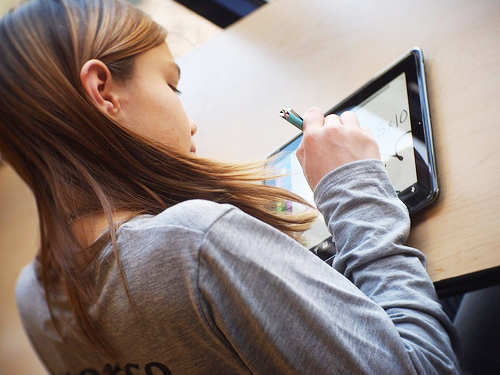By Matt Levinson
For schools that are about to deploy the iPad as their main mobile learning device, there's wisdom to be learned from others who've gone down that road. At Marin Country Day School in Corte Madera, Calif., the first year of a pilot iPad program for sixth-graders has just ended, and some clear lessons have emerged. Here are some tips to help smooth the transition.
- START CLASS WITH GOOD HABITS. Start out the day with a learning challenge like Google a Day to get students using and searching the iPad in a productive manner, instead of coming in to homeroom, advisory, or classroom and going into their own applications or searches.
- ASK KIDS FOR HELP. Don't hesitate to lean on kids for tech support and assistance. Tapping a student to come up with a way to fix a problem with the iPad is a great way to empower students, and gives them a sense of ownership.
- INVEST IN A DURABLE CASE. The initial investment will lower costs down the line if devices are are broken, and will cut down insurance premiums.
- IDENTIFY DEVICES. Use laminated name tags and have kids personalize their cases with a key chain. You can also ask each homeroom have a different key chain for easy identification. Also ask kids to put their names on their home screens. This is an easy way to identify ownership of the iPad and allows kids the opportunity to personalize and customize their devices.
- PROVIDE A FEW WIRELESS KEYBOARDS. Though most kids will opt to use the iPad keyboard, the wireless keyboards will come in handy now and then. That said, kids who have mobile phones and text a lot are quick iPad typists and their fingers are smaller and more nimble than adult fingers. Watch how they explore the split keyboard feature to enable and mimic texting like typing.
- DECIDE iTUNES POLICY. Determine whether the school will control iTunes or whether students and families will have ownership and control to purchase apps -- there are pros and cons to each. In the first year of an iPad deployment, having the school control iTunes allows for equity and access for all students. Students and families can always suggest apps for the school to purchase. On the other hand, giving full access to iTunes to students and families allows for greater personalization and exploration and releases the school from having to widely upload new apps for use. Each community is different and needs to do what fits best and is most appropriate to the needs of its community.
- FIGURE OUT WORKFLOW APPS. There are many different options, like Box, e-Backpack, Evernote or DropBox to name just a few. Whichever system you decide upon, have everyone use the same system to ensure consistency and to minimize the need to troubleshoot different systems.
CONSIDER PURCHASING AN APPLE TV. An Apple TV will project what's on the iPad and allow for greater teacher mobility in the classroom. Though it's an additional cost, it would also address teachers' complaints about the slipping of the cord attachment between the iPad and the projector, which can be disruptive.
- CHECK YOUR BANDWIDTH. Make sure you have enough bandwidth to manage use of all the devices on campus -- and test it regularly.
- HAVE A PLAN FOR MISSING DEVICES. Kids will misplace the iPads around campus, at home and on the bus, so have a plan in place for how to communicate missing devices. For example, send a blast email to let staff know the iPad is missing and have designated locations where iPads should be returned, and make sure everyone knows of these locations.
- INDICATE YEA OR NAY. If you're not using the iPad everyday, post a visual in the classroom for whether the iPad will be used that day in class. For example, a red light signals no iPad, a yellow light indicates maybe and a green light means get the iPad out and ready to use right away. This will save the daily question, "Are we using the iPads today?"
- FOLLOW THE KIDS' LEAD. Because of its mobility and versatility, unexpected opportunities will come up. Indulge the kids' ideas, whether it's to photograph parts of the campus and design math programs using proportional reasoning or to record and interview members of the community or to embark on a QR code treasure hunt.
- EXPECT THE UNEXPECTED. No matter how much you prepare and put plans in place, you need to be ready for the detail you didn't see coming. Be flexible and adaptable and make sure your school team adopts the same mindset. You can't take on an iPad program and be rigid.
- HAVE FUN! Moving to an iPad program can be a blast for kids, teachers and administrators and has the potential to spark imagination and creativity.


